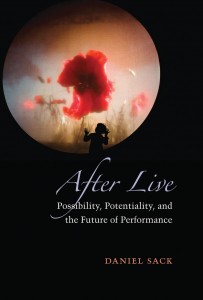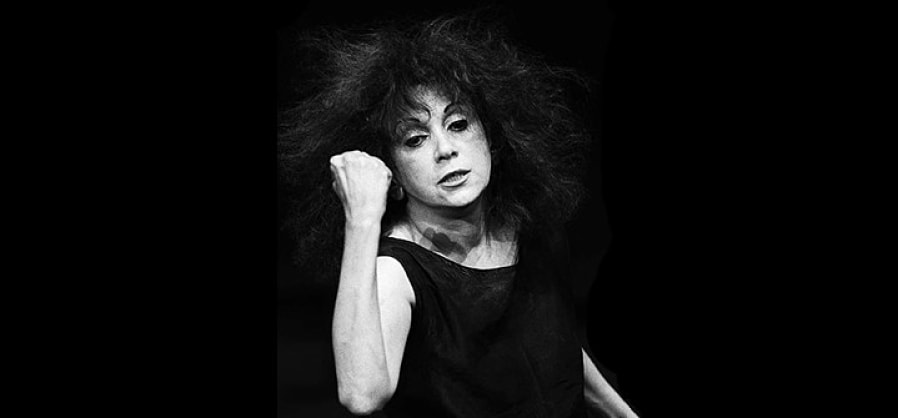For six years I worked with Judith Malina and the Living Theatre, which she cofounded; in another chapter in my life, I was in graduate school at Stanford with Daniel Sack. That each of these figures from my theatrical life recently brought out new nonfiction books is an occasion of personal significance, certainly, but it is more than that. Though they didn’t know each other, I believe Malina’s and Sack’s disparate works address each other in a profound and meaningful way.
When conceptualizing my review, I developed a simple, rudimentary framework that would help make this connection clear. But when dealing with issues of living and afterlife, rudimentary frameworks collapse quickly. When I speak of afterlife in the case of the Malina, I am not referring to a grandiose religiosity involving angels and St. Peter, nor am I speaking of the considerably more modest Hasidic belief that the next world is a replica of this one, just slightly different.
Rather, I am referencing the remnant, the ontological trace—that which we who are left behind try to sustain. Inevitably, that trace is perverted by the rememberer. It can be mythologized, destroyed, or deconstructed, but as the act of remembrance is a selective one, our individual acts of selection end up presenting at best an incomplete picture of the remembered, and at worst a completely fictionalized character. This process is inevitable, unless, as Judith Malina does in Full Moon Stages, you succeed in inscribing your name on the wall of history.

The form of Full Moon Stages is beautiful in its simplicity. On every full moon between 1964 and 2014, Malina wrote four or five lines about what was happening in her life. In my own time working with the Living Theatre, a history of the company was published. When I asked Judith what she thought of the book, her response was telling. “It’s a good prosaic account of my life,” she said, “but I always thought I lived in poetry.” I knew of the existence of her Full Moon Poems (as the collection was then known) but never saw it until it was published in its current form. With Full Moon Stages, Malina proves the prose/poetry distinction.
Indeed, the more I thought about it, the more I realized that this book is not in fact a book, but rather an atypical explicit performative utterance. Unlike J.L. Austin’s explicit performance speech acts, which are expressed in one sentence, Malina’s is a book-length speech act, saying: “I am here.” Although Malina was too modest to ever make the following claim, I will go one step further and say that the perlocutionary effect of this utterance can be expressed as, “Because of my abiding belief in the Beautiful Non-Violent Anarchist Revolution, and my resolute performance of that belief in daily life, the world is changed by my existence in it.”
As I sat at my dining room table and read Full Moon Stages from cover to cover in one sitting, I realized that not only doesn’t Malina’s work function as a book; it is not constituted as one. Penny Arcade makes reference to this in her back-cover blurb, in which she calls the work a “fattura, or spell.” While this notion is useful and worth further interrogation, I prefer to view the piece as performance. Full Moon Stages transcends the reception model that comprises most books, by which one simply absorbs information in the hope of better understanding the subject matter at hand, and demands of the reader an intensity of psychic and durative commitment that is difficult to summon in these days of instantaneity. This book-length poem privileges experientiality over intellectual understanding, asking that you take the trip and allow yourself to be changed by the journey.
If one commits to taking the Malinian trip, this story of a life, told sequentially yet in fragments, as if it were an existence illuminated by lightning bolts, is one of the most powerful interactions I’ve ever had with a piece of nonfiction. As I sat at the table after finishing it, tears streaming down my face, I could not help but reflect on all that remained to be done. Yes, Malina’s achievements are remarkable, and her passion commendable, but her contribution to our theatrical and social discourse was much more profound than the simple force of her personality. She created a path where there was none—a new way of thinking about the potential of theatre to confront the larger society, both in form and content, while sustaining an atmosphere that was open and emotionally generous.
If, as I suspect, Malina used her interactions with others to perform her vision of the postrevolutionary future, the potential and possibility for a better world that was inscribed in her quotidian interactive performance created in many others a desire to continue the work of actualizing the Beautiful Non-Violent Anarchist Revolution.
It is here, in the liminal space where visions of the future dance unfettered and unbound, that Malina and Sack meet. But before we can explore the relationship between these two works, we must engage directly with Sack’s book. After Live: Possibility, Potentiality, and the Future of Performance is a major theoretical achievement and an important addition to the extant body of performance scholarship. Notably, it comes from someone extremely early in his scholarly career.

But while the quality of the work is remarkable, to me it is unsurprising. As I mentioned, I attended graduate school with Sack, along with two others: Adelina Anthony and Florentina Mocanu-Schendel. As the instruction was seminar-based, the four of us spent many hours sitting around large rectangular tables together. While the rest of us were not shy about sharing our thoughts, Daniel would sit quietly, actively listening. Eventually, he would make a comment that would inevitably open up the discussion, often bringing it to a higher level of discourse. As I watched him over the years, it became clear to me that he verbalized only about 10 percent of what he thought—an inverse ratio, sadly—and I always wondered what ideas he wasn’t sharing.
With the publication of this book, I now know. The work is so nuanced and layered that it is impossible to do it justice in a review-length piece; the only complete review would be a book written in response. All I can do here is pull on a few strands I hope can suggest the entire tapestry.
As with Malina’s work, the subject matter is inseparable from the writer. The work is fluid and inventive, and through it Sack shows us his potential as a thinker and as a scholar; he is clearly a contender to be one of a handful of academics who will define our thinking about the future of performance. The first page features an infamous quote from Donald Rumsfeld:
As we know,
There are known knowns.
There are things we know we know.
We also know there are known unknowns
That is to say
We know there are some things
We do not know.
But there are also unknown unknowns
Things we don’t know
We don’t know.
It is quite edifying that Sack begins his work with this quote, as his book is very invested, to borrow a phrase from Slavoj Zizek, in tarrying with the negative. The temptation here is to declare that Malina interrogates the utopic project, Sack the dystopic—to give both analyses equal valence and conclude that they are two sides of the same coin. Q.E.D.
But to do so would be to draw a false equivalence. Malina is invested in the actualization of the utopic, while Sack merely investigates the dystopic landscape. Malina lives in the building; Sack reports that the building might burn down at any moment. Sack uses Rumsfeld’s gnostic pronouncement to declare that true potentiality can only exist in the unknown unknown, as it “breaks with the expected orders of past and present to perform an indeterminate future without rational end or function.” This statement positions both the known and the unknown in the future: The known is foreseeable, the unknown unimaginable, and therefore it is only in the unknown unknown that true potentiality lies.
For the first half of After Live, Sack’s vehicle for examining potentiality is the figure of Herman Melville’s “Bartleby, the Scrivener.” With his choice of subject, Sack extends his definition of performance to include the quotidian, once again recalling Malina. Although there is some discussion of Bartleby as a character, the primary focus is on his transformative performative utterance, “I’d prefer not to.”
Bartleby is a copyist who refuses to reproduce, whether it be a legal document, the unspoken hierarchical contract between employer and employee, or even, as he is described as dying alone, in matters of physical love. Sack positions Bartleby as an exemplar of potentiality, as his “formula gives voice to the fact that he is able to not do that which the law(yer) demands of him.” In other words, for Sack potentiality is grounded in competence. Without the ability to fulfill a request, one cannot decide how to respond, for the decision has already been made.
While I concur with Sack on this point, Bartleby is an important figure in American literature and thought for another reason as well: He shatters the idea of the binary. Bartleby troubles the quotidian yes/no, will/won’t, and births a third, more nuanced response. As Malina was committed to revolutionary activity, so is Bartleby committed to revolutionary passivity.
The second half of After Live is devoted to an exploration of the post-millennial work of Socìetas Raffaello Sanzio (hereafter SRS). One of the leading U.S. authorities on this Italian company, Sack guides us through their work, provides context and background, and makes a passionate case for their inclusion as one of the great experimental theatres of our time. Once again, Sack focuses on a company that is actively engaging questions of being and apocalypse. In doing so, he further interrogates the dystopic. Sack acknowledges the limits of theatricality by stating, “The door into the outside world stands open, and when the audience leaves the theatre to descend into sunlight the space remains behind.”
However—and this is difficult to unpack, as it is extratextual—the length of Sack’s musing on apocalyptic potentiality, both within and without the work of SRS, and the minute detail with which he describes the troupe’s attempts to stage the apocalypse, speak to an unsettling preoccupation with a post-human future. Sack addresses this by stating that he has “perhaps too easily been enthralled by the seductions of these performances of potentiality. These actualizations of potentiality propose a world to come absent humanity and willingly court the tantalizing awe of the sublime as self-eradication” (italics mine). While this semi-apology is reassuring from a purely human standpoint, I must trouble Sack’s fetishization of the apocalyptic.
Both Malina and Sack directly engage the polis, and in doing so encourage us to embark upon our own exploration. Judith claims the poetic past, while Daniel charts a path for the theoretic future. Meanwhile, we the reader/audience are moored in the ineluctable present. As I contemplate the mounting horrors of a world newly at war (from Paris to Beirut, Mali to San Bernardino), it occurred to me that the revolutionary moment that Judith dreamed of might be here, and that Sack’s apocalyptic focus was not simply a reflection of his thought but rather the only honest grounding for a book attempting to address the future.
The revolution is here, and it is theocratic. In this historic moment, to speak of apocalyptic performance in the face of Paris (especially Paris, as the targets were public spaces—gathering places dedicated to enjoyment, whether it be sporting or artistic) seems ludicrous and insulting to those who were robbed of the possibility of any further potentiality. If the performance of the apocalypse is both the most noble project and the future of theatre, then ISIS/Daesh is the best theatre company in the world. This is a possibility I refuse to entertain.
Of course, theocracy can take many forms, depending on the god one prays to. In the United States, our primary god is Mammon, and in such a Mammonite society, human possibility is tied to financial status. Lack of access to capital profoundly limits the development of one’s abilities. Applying the Sackian formula, capitalism acts as a barrier to achieving competence, therefore placing severe constraints on the potentiality of the great majority of our citizenry.
Malina’s Full Moon Stages and Sack’s After Live speak not only to each other in a meaningful sense; they each give us a framework for resisting the theocratic revolution. Naturally, Sack’s is more theoretical, serving as a warning about the enticing lure of the apocalyptic, and Malina’s more poetic, focusing on the utopic project, as those are their native tongues. While I remain unconvinced that any amount of performance, theory, or poetry can reverse the tide of world events since 2001, there are two concepts Judith instilled in me that I refer to in these difficult times. The first is that the theatre must be attractive (in a gravitational sense), and the second is that it must communicate—it must address people where they are and not where you want them to be.
One final connection between Sack and Malina is their quiet religiosity. Sack references Christ in his book, and Malina, the daughter of Rabbi Max Malina, attended an Orthodox synagogue. And so, in trying to preserve Judith’s vision of a revolution that was beautiful, peaceful, and inclusive, I feel compelled to attempt to simultaneously speak the theocratic language and send a message of hope to you, the reader. And so, from Micah 4:4:
Everyone will sit under their own vine, and under their own fig tree, and no one will make them afraid.
Brad Rothbart is a freelance dramaturg, writer, and theorist. He aims to become the first visibly physically disabled artistic director of a major American resident theatre.




